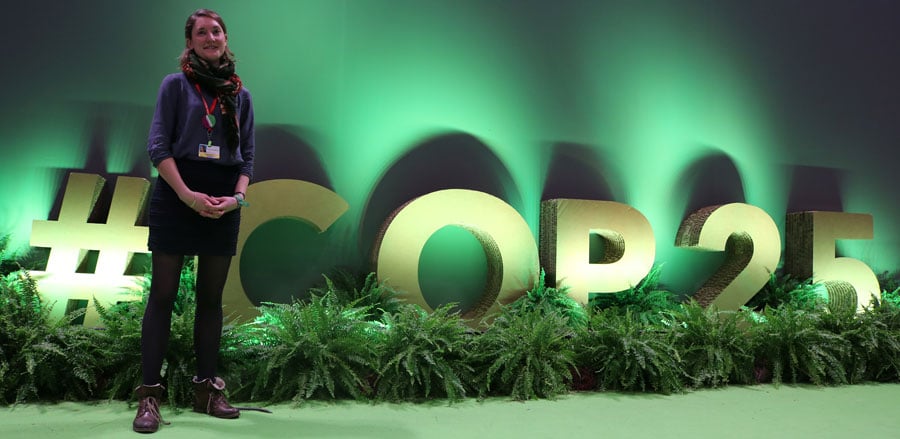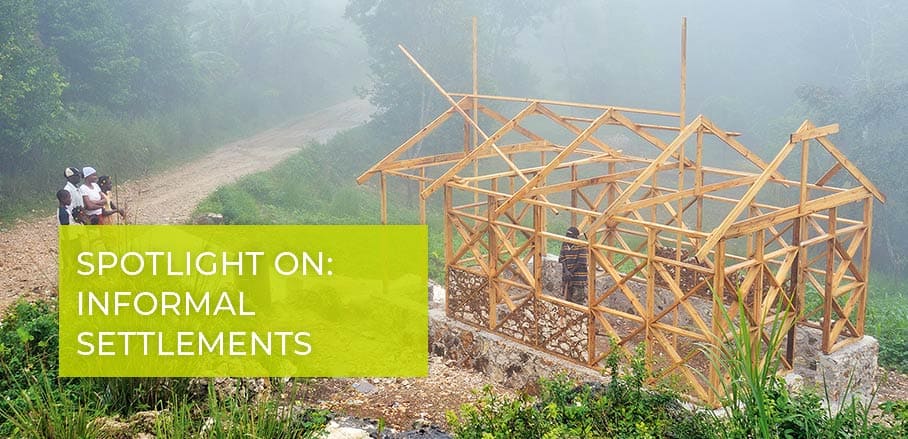Climate Change: What Happens to People Living in Informal Settlements?
At COP25, the Desk Officer for Sustainable Urban Development at MISEREOR, Clara-Luisa Weichelt, talked to Emanuela Barbiroglio about the challenges of addressing climate change in informal settlements and human-rights based solutions.
Informal Settlements Are On The Rise
According to a 2013 study from the United Nations Human Settlements Programme UN-Habitat, an estimated 25 per cent of the world’s urban population live in informal settlements. Considering the population increase and the massive migration from rural areas to big cities, by December 2019 this figure translates into an estimated total of 1.9 billion people living in informal settlements.
Clara-Luisa Weichelt is the Desk Officer for Sustainable Urban Development at MISEREOR, the German Catholic Bishops’ Organisation for Development Cooperation, which was founded in 1958 to support the weakest members of society in the Global South.

© Emanuela Barbiroglio
Weichelt attended the climate summit COP25 in Madrid and, together with MISEREOR partner organisations, held a panel discussion on the link between the climate crisis, climate policies and habitat standards. Climate change is increasing human rights violations for the most disadvantaged communities. The panel presented solutions for mitigation and adaptation on a range of issues, including housing, water and infrastructure development, and the concept of the ‘right to the city’.
“We support local organisations to tackle poverty and environmental problems that are intrinsically linked to social challenges,” Weichelt tells me. “We support the demands and perspectives of the most vulnerable in international politics, we link challenges as well as solutions from the Global South to the Global North, and we strive to improve living conditions on a local level.”
The Root Of The Problem Is A Lack Of Rights
MISEREOR also wants to create, on a political and economic level, the necessary frameworks that vulnerable people need for living a life in dignity. “For me, it’s a lot about mutual learning,” Weichelt says. “I learn from our partner organisations about their fights and perspectives, in order to further develop our cooperation and to find the best ways to reach our common objectives.”
People living in precarious conditions or in risky areas do so because they are forced. They either have no affordable housing solution, or land is difficult to access.
“People live close to riverbanks, on the coast, on steep slopes, their houses are in bad conditions. In many cases they have to build poor constructions out of the material they can find,” Weichelt says. “Those people are vulnerable anyway because their basic human rights are not being fulfilled. Governments usually don’t care about them because they have no official land titles and their rights are often disregarded.”
The most difficult challenge to overcome is the violation of human rights related to adequate standards of living, housing, and water as well as the right to a healthy environment. Similarly, gender equality and equity remain an issue.
However, as COP25 failed to deliver any decisions on Article 6 of the Paris Agreement regarding carbon markets and their impacts on human rights, it just proved that politics are still too weak to protect vulnerable populations. Just a little progress was made on financing losses and damage that affects the most vulnerable populations.
When Addressing Climate Change, Everyone’s Needs Must be Taken into Consideration
Climate change intensifies the risks people living in informal settlements already face. Even though these people did not contribute to the climate emergency, they are now suffering more than others as extreme weather events increase.
“Their living conditions cannot withstand extreme weather events. For example, when heavy rainfall becomes more frequent and rivers get flooded as a consequence, this damages their houses or washes them away and puts their lives at risk. It’s the same story with sea level rise and typhoons, like the one that recently hit the Philippines.”
This is why MISEREOR came to COP25 in the first place. “We are here to demand that the needs of people living in human settlements are considered in climate policies and to show that they are the ones who primarily need to be protected against the impacts of climate change. They must benefit from climate action and not suffer from it.”
The whole debate on human rights within climate negotiations is very important for NGOs, because climate actions must be aligned with people’s needs.
For instance, projects that are financed within the Clean Development Mechanism often violate rather than protect human rights. That’s the case in Alto Maipó in Chile, where the building of a hydroelectric dam affects the access to water for millions of people, including those living in the capital Santiago de Chile. Other examples of climate adaptation projects, such as the building of the Tide Embankment Project in Tacloban in the Philippines, show that the needs of the most vulnerable people are often not considered by national governments. In Tacloban, 100,000 people will be relocated to areas far away from the cities and without adequate solutions for how they will live in the future.
“That’s not an adequate way to deal with the crisis,” Weichelt says. “It’s obvious that protection for people living in the city is necessary and there has to be a plan on how to adapt to and deal with climate change. But it has to be done in a participatory manner and in line with the rights of all the people affected.”
There Are Alternatives
MISEREOR’s partner organisations have been working with communities to find alternative solutions that do not lead to rights violations or their displacement. For example, flood protection by planting mangroves, making sure that people can remain within their communities and close to their place of work, or building better houses.
Weichelt adds that MISEREOR partners deal with climate mitigation and adaptation by building low-emission and resilient houses: “We support the construction of houses and infrastructure to improve the living conditions of the people, through building techniques based on local knowledge and local materials that are available in the community. At the same time, these construction methods are climate-friendly.”
She believes that what is really necessary is to think about solutions that are people-centered, consider low-income populations, and that are based on local practices and experiences. “We want to reach out to political decision-makers, enterprises and civil society in order to hold them responsible. Together, we can develop solutions that enable a life in dignity for everybody whilst also respecting the limited resources of our planet and future generations.”
- Climate Change: What Happens to People Living in Informal Settlements? - 16. January 2020
- COP 25 – What Impact on Cities and Regions? - 17. December 2019
- COP25– A Chance To Discover Cities’ Potential - 2. December 2019
